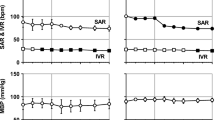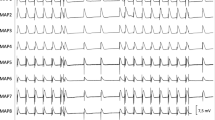Summary
DPI 201-106 (DPI), a novel and potent cardiotonic agent, exhibits its effects by prolonging the open state of Na+ channels, resulting in an increase in action potential duration, and thus, is supposed to share the class III antiarrhythmic activity. The effects of DPI on the hemodynamics, intraventricular conduction and refractoriness of heart, and the incidence of arrhythmias induced by programmed electrical ventricular stimulation (PES) were compared with (±)-dobutamine. Dogs which survived for 5 to 7 days after the induction of myocardial infarction were used as the model. The presence of sub-acute myocardial infarction caused by occluding the left anterior descending coronary artery elicited a mild left ventricular dysfunction represented by a significant decrease in peak LV dp/dt by about 20%.
Both i.v. bolus injection of DPI (1, 3 and 5 mg/kg) and i. v. continuous infusion of dobutamine (3, 5 and 10 μg/kg/min), which were administered in a cumulative manner, dose-dependently improved the hemodynamic parameters. At the higher doses of both DPI (3 and 5 mg/kg) and dobutamine (5 and 10 μg/kg/min) the control values were reached or even exceeded. DPI dose-dependently increased the effective refractory period (ERP) of both non-infarcted and infarcted ventricular myocardia to a similar degree, but the conduction time showed a frequency-dependent increase in the infarcted myocardium to a greater degree than in the non-infarcted myocardium after DPI. In contrast, dobutamine decreased the ERP in both non-infarcted and infarcted myocardia, and slightly increased the difference of refractoriness between the non-infarcted and infarcted zones with no effect on the intraventricular conduction. In the PES study, DPI (3 and 5 mg/kg) produced a significant decrease in the incidence of ventricular tachycardia, whereas dobutamine (5 and 10 μg/kg/min) tended to worsen the arrhythmias. These findings suggest that cardiotonic agents with a class III antiarrhythmic property such as DPI may be potentially useful for the management of heart failure accompanied by ischemic heart disease.
Similar content being viewed by others
Abbreviations
- DPI, DPI 201-106; PES:
-
programmed electrical ventricular stimulation
- LV dp/dt:
-
the rate of rise of left ventricular pressure
- ERP:
-
effective refractory period
- RVOT:
-
right ventricular outflow tract
- VT:
-
ventricular tachycardia
- LAD:
-
left anterior discending coronary artery
References
Brachmann JB, Scherlag BJ, Rosenshtraukh LV, Lazzara R (1983) Bradycardia-dependent triggered activity: Relevance to drug induced multiform ventricular tachycardia. Circulation 68:846–856
Butrous GS, Debbas NMG, Erwin J, Davies DW, Keller HP, Lunnon MW (1988) Clinical cardiac electrophysiologic evaluation of the positive inotropic agent, DPI 201–106. Eur Heart J 9:489- 497
Clusin WT, Bristow MR, Karagueuzian HS, Katzung BG, Schroeder JS (1982) Do calcium-dependent ionic currents mediate ischemic ventricular fibrillation? Am J Cardiol 49:606–612
Cody RJ (1988) Do positive inotropic agents adversely affect the survival of patients with chronic congestive heart failure? J Am Coll Cardiol 12:559–569
El-Sherif N, Scherlag BJ, Lazzara R, Hope RR (1977a) Reentrant ventricular arrhythmias in the late myocardial infarction period 1. Conduction characteristics in the infarction zone. Circulation 55:686–702
El-Sherif N, Hope RR, Scherlag BJ, Lazzara R (1977b) Reentrant ventricular arrhythmias in the late myocardial infarction period 2. Pattern of initiation and termination of reentry. Circulation 55:702–719
El-Sherif N, Zeiler RH, Graelius W, Gough WB, Henkin R (1988) QTU prolongation and polymorphic ventricular tachyarrhythmias due to Bradycardia-dependent early after depolarizations and ventricular arrhythmias. Circ Res 57:432–442
Gerard JL, Berdeaux A, Giudicelli JF (1989) Cardiac and hemodynamic profile of the new cardiotonic agent, DPI 201–106, in the conscious dog. Eur J Pharmacol165:39–49
Gerard JL, Berdeaux A, Guidicelli JF (1990) Cardiac and hemodynamic effects of S(−)- and R(+)-DPI 201–106 and of racemic DPI 201–106 in conscious dogs. Eur J Pharmacol 184:321–323
Gloor HO, Kappenberger LJ (1985) DPI 201–106: A positive inotropic agent with prolongation of the QT-interval. Circulation 72 [Suppl 3]:235
Harris AS (1950) Delayed development of ventricular ectopic rhythms following experimental coronary occlusion. Circulation 1:1318–1329
Hogan JC, Greenbaum RA, Lunnon MW, Hilson AJW, Evans TR (1988) Haemodynamic effects of DPI 201–106, following single intravenous dose administration to patients with moderate cardiac failure. Eur Heart J 9:498–502
Josephson ME, Horowitz LN, Farshidi A (1978) Continuous local electrical activity. A mechanism of reentrant ventricular tachycardia. Circulation 57:659–665
Josephson ME, Horowitz LN, Spielman SR, Greenspan AM (1980) Electrophysiologic and hemodynamic studies in patients resuscitated from cardiac arrest. Am J Cardiol 46:948–955
Kohlhardt M, Frobe U, Herzig JW (1986) Modification of single cardiac Na+ channels by DPI 201–106. J Membr Biol 89:163–172
Kostis J, Lacy C, Raia J, Dworkin J, Warner R, Casazza L (1987) DPI 201–106 for severe congestive heart failure. Am J Cardiol 60:1334–1339
Krell MJ, Klein EM, Bates ER, Hodgson JM, Dilworth LR, Laufer N, Vogel RA, Pitt B (1986) Intermittent ambulatory dobutamine infusions in patients with severe congestive heart failure. Am Heart J 112:787–791
Kupersmith J, Antman EM, Hoffman BE (1975) In vivo electrophysiological effects of lidocaine in the canine acute myocardial infarction. Circ Res 36:84–91
LeJemtel TH, Sonnenblick EH (1984) Should the failing heart be stimulated? N Engl J Med 310:1384–1385
Lubbe WF, Podzuweit T, Daries PS, Opie LH (1978) The role of cyclic adenosine monophosphate in adrenergic effects on ventricular vulnerability to fibrillation in the isolated perfused rat heart. J Clin Invest 61:1260–1269
Lynch JJ, DiCarlo LA, Montgomery DG, Lucchesi BR (1986) Electrophysiologic effects of bepridil in normal and infarcted canine myocardium. J Cardiovasc Pharmacol 8:957–966
Lynch JJ, Uprichard ACG, Frye JW, Driscoll EM, Kitzen JM, Lucchesi BR (1989) Effects of the positive inotopic agents mirinone and pimobendan on the development of lethal ischemic arrhythmias in conscious dogs with recent myocardial infarction. J Cardiovasc Pharmacol 14:585–597
Marinchak RA, O'Connor KM, Friehling TD, Kowey PR (1989) Acute electrophysiological effects and antiarrhythmic/antifibrillatory activity of intravenous amiodarone in a chronic feline infarction model. J Cardiovasc Pharmacol 14:389–395
Michelson EL, Spear JF, Moore EN (1980) Electrophysiologic and anatomic correlates of sustained ventricular tachyarrhythmias in a model of chronic myocardial infarction. Am J Cardiol 45:583–590
Mortensen E, Tande PM, Klow NE, Platou E, Refsum H (1989) Class III antiarrhythmic effect of Na+ channel activation? Electrophysiological effects of DPI 201–106 in vivo. J Mol Cell Cardiol 21 [Suppl 4]:S51
Packer M (1989) Therapeutic options in the management of chronic heart failure: Is there a drug of first choice? Circulation 79:198–204
Packer M, Medibna N, Yachuk M (1984) Hemodynamic and clinical limitations of long term inotropic therapy with amrinone in patients with severe chronic heart failure. Circulation 70:1038–1047
Patterson E, Lynch JJ, Lucchesi BR (1984) Antiarrhythmic and antifibrillatory actions of the beta adrenergic receptor antagonist, d,l-sotalol. J Pharmacol Exp Ther 230:519–526
Salzmann R, Scholtysik G, Clark B, Berthold R (1986) Cardiovascular actions of DPI 201–106, a new cardiotonic agent. J Cardiovasc Pharmacol 8:1035–1043
Schoeller R, Schroeder K, Neise B, Schroeder R (1989) Acute and chronic effects of DPI 201–106, alone and in combination with captopril in advanced cardiac insufficiency. Z Kardiol 78 [Suppl 4]:19
Scholtysik G, Salzmann R, Berthold R, Herzig JW, Quast U, Markstein R (1985) DPI 210–106, a novel cardioactive agent. Combination of cAMP-independent positive inotropic, negative chronotropic, action potential prolonging and coronary dilatory properties. Naunyn-Schmiedeberg's Arch Pharmacol 329:316–325
Scholtysik G, Williams M (1986) Antiarrhythmic effects of DPI 201–106. Br J Pharmacol 89:287–292
Scholtysik G, Salzzmann R, GerberW (1989) Interaction of DPI 201–106 with cardiac glycosides. J Cardiovas Pharmacol 13:342–347
Siegl PKS, Wenger HC (1986) DPI 201–106 vs milrinone: Hemodynamic responses in an acute, canine model of heart failure. Circulation 74 [Suppl 2]:267
Thormann J, Kramer W, Kindler M, Kremer FP, Schlepper M (1986) Comparative efficacy of the new cardiotonic agent DPI 201–106 versus dobutamine in dilated cardiomyopathy: Analysis by serial pressure/volume relations and “on-line” MVO2 assessment. J Cardiovasc Pharmacol 8:749–757
Tuttle RR, Mills J (1975) Dobutamine. Development of a new catecholamine to selectively increase cardiac contractility. Circ Res 36:185–196
Vaughan Williams EM (1985) Cardiac electrophysiology effects of selective adrenoceptor stimulation and their possible roles in arrhythmias. J Cardiovasc Pharmacol 7 [Suppl 5]:S61-S64
Walker MJ, Tuna IC, Gornick CC, Goldenberg IF, Almquist A, Milstein S, Benditt DG (1989) Cardiac electrophysiologic effects of orally administered DPI 201–106 in conscious canines: Effects of pharmacologic autonomic blockade or cardiac transplantation. J Cardiovas Pharmacol 14:381–388
Wellens HJJ, Brugada P, Farre J (1984) Ventricular arrhythmias: Mechanisms and actions of antiarrhythmic drugs. Am Heart J 107:1053–1057
Willerson JT, Hutton I, Watson JT, Platt MR, Templeton GH (1976) Influence of dobutamine on regional myocardial blood flow and ventricular performance during acute and chronic myocardial ischemia in dogs. Circulation 53:828–833
Author information
Authors and Affiliations
Additional information
Send offprint requests to T. Uematsu at the above address
Rights and permissions
About this article
Cite this article
Ozaki, T., Uematsu, T., Nagashima, S. et al. Effects of DPI 201-106, a novel cardiotonic agent, on hemodynamics, cardiac electrophysiology and arrhythmias induced by programmed ventricular stimulation in dogs with subacute myocardial infarction: A comparative study with dobutamine. Naunyn-Schmiedeberg's Arch Pharmacol 344, 478–487 (1991). https://doi.org/10.1007/BF00172589
Received:
Accepted:
Issue Date:
DOI: https://doi.org/10.1007/BF00172589




